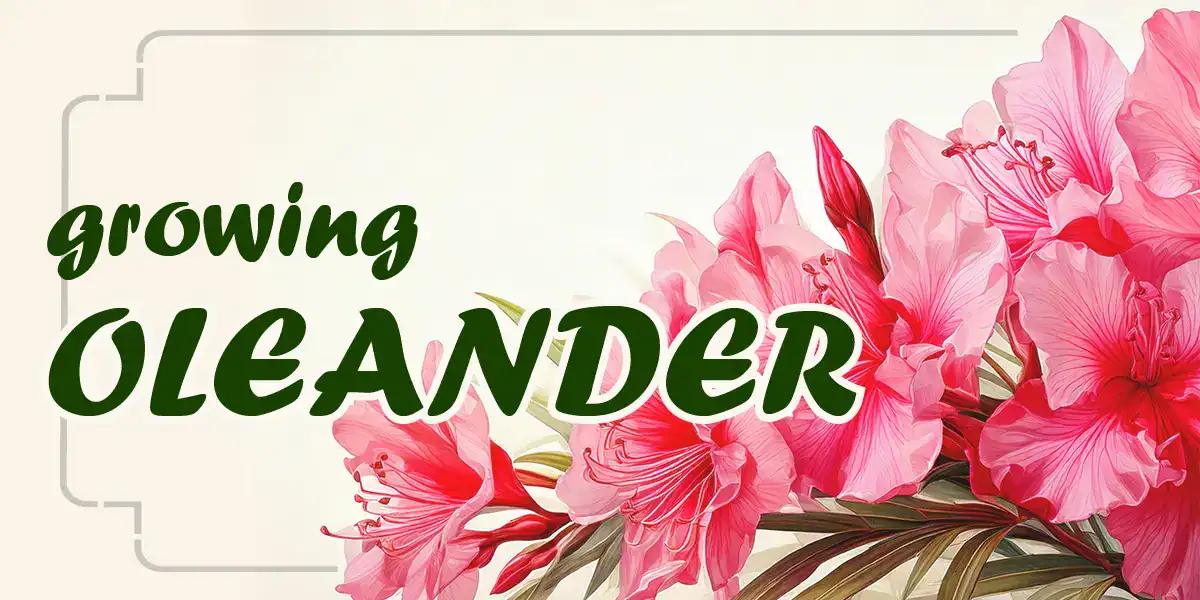Oleander might be the perfect plant for Southern California’s climate. This Mediterranean native thrives in heat, tolerates drought, and blooms nearly year-round in mild winters.
Whether working with a small balcony or a sprawling backyard, oleander delivers outsized visual impact with minimal fuss.
Some historians theorize that its noxious smoke contributed to the Oracle of Delphi’s mystical trances (we don’t recommend you try). More practically, it’s incredibly versatile, with over 400 cultivars available in a range of flowering colors, from pure white to deep red.
Origins of Oleander
Oleander (Nerium oleander) is a plant from the Mediterranean Basin that grows naturally along streambeds and rocky hillsides. The genus Nerium is etymologically linked to the Greek word “water” or “wetness,” reflecting its preference for areas with seasonal moisture.
Oleander is the sole species in its genus, a botanical rarity. This single species adapts so well that it has naturalized across warm regions worldwide.
Note: Oleander is toxic when ingested or burned and should be kept out of reach of children and pets.
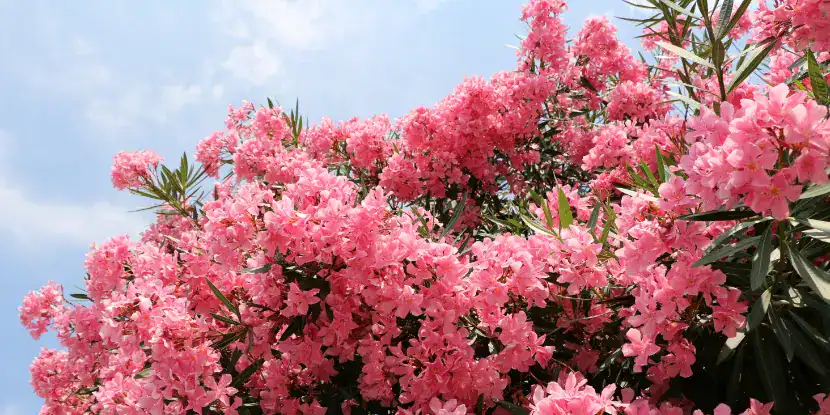
An explosion of pink oleander blooms.
Why Oleander Might Be Your Best Low-Water Hedge
Southern California’s Mediterranean climate mirrors oleander’s native habitat. Here’s why the plant does so well:
- Heat tolerance: It thrives in temperatures up to 100°F
- Drought resistance: It survives on minimal water once established
- Coastal adaptability: It handles salty air and ocean breezes
- Wind resistance: Dense growth makes excellent windbreaks
- Extended blooming: It flowers spring through fall (sometimes longer)
- Deer resistance: Toxicity keeps wildlife away
California highways feature millions of oleander plants precisely because they handle challenging conditions with minimal maintenance.
Height & Spread
- Most oleander cultivars grow to about 8 to 12 ft tall and almost as wide (i.e., spread ≈ height)
- In warm, protected sites, some may reach up to 20 ft tall
- Typical spread is in the 6 to 10 ft range for many full-size varieties
- Dwarf or “petite” cultivars are considerably smaller, often in the 3–5 ft height and spread range
- Pruned oleander can remain at a shrub height or be trained into a small tree
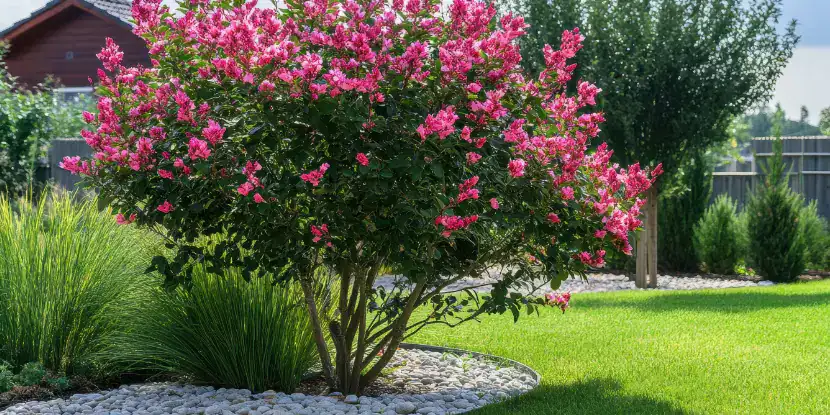
Pink oleander pruned into a small tree.
Optimal Growing Conditions
Light
- Oleander performs best in full sun (6+ hours daily) but tolerates partial shade.
- More sun equals more blooms and denser foliage.
- In extremely hot inland areas, afternoon shade can prevent leaf scorch.
Temperature
- Oleander is hardy in USDA zones 8-11, and handles Southern California’s temperature swings beautifully.
- It can survive brief dips to 15°F, but may experience some die-back.
- Move container plants to protected areas during rare freezes.
Soil
Oleander adapts to various soil types but prefers:
- Well-draining soil (crucial for preventing root rot)
- pH range of 6.0-8.0 (slightly acidic to alkaline)
- Sandy or loamy texture
- Poor to moderately fertile soil (too-rich soil reduces flowering)
- Heavy clay soils should be amended with sand or perlite for better drainage.
Propagating Oleander
Stem cuttings offer the easiest propagation method:
- Take 6-8 inch cuttings from healthy stems in spring or early summer
- Remove lower leaves, keeping 4–6 leaves at the top
- Dip in rooting hormone (optional but helpful)
- Plant in a well-draining potting mix
- Keep soil consistently moist but not waterlogged
- Place in bright, indirect light
- Expect roots in 4–6 weeks
Seeds are possible but slow and unreliable. Cultivars won’t grow true to type from seed.
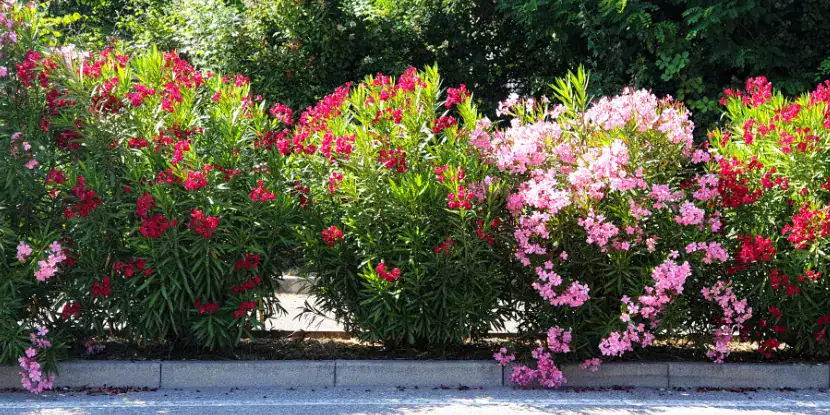
A hedge of various oleander cultivars.
Steps for Planting
For garden beds:
- Choose a sunny location with good drainage
- Dig a hole twice as wide as the root ball, same depth
- Mix native soil with compost (25% compost maximum)
- Place the plant at the same depth it was growing in the container
- Backfill and water thoroughly
- Apply a 2-3 inch mulch layer, keeping mulch away from the stem
Spacing considerations:
- Standard varieties: 6–8 feet apart
- Dwarf cultivars: 3–4 feet apart
- For hedges: 4–5 feet apart
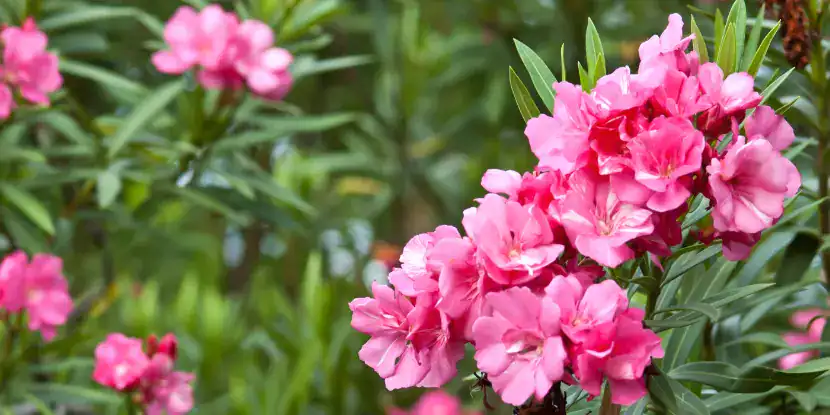
Close-up of vibrant pink oleander flowers.
Oleander Care
Water
Establishment phase (first year): Water deeply twice-weekly during the growing season. Reduce frequency in winter.
Mature plants are very drought-tolerant. During the summer heat, soak the roots every 2–3 weeks. Allow the soil to dry between waterings. Overwatering causes more problems than underwatering.
Fertilizer
Oleander rarely needs fertilization. If growth seems slow:
- Apply a balanced fertilizer (10-10-10) once in early spring
- Avoid high-nitrogen fertilizers (promote leaves over flowers)
- Compost top-dressing in the fall provides gentle nutrition
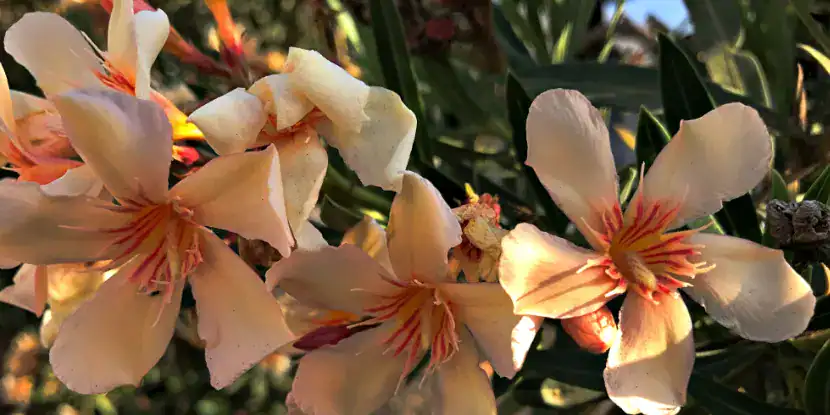
Creamy pinkish laurel blossoms.
Pests & Diseases
Common pests:
- Aphids: Spray with water or insecticidal soap
- Scale insects: Use horticultural oil
- Caterpillars: Hand-pick or use Bt spray
Disease issues:
- Leaf scorch: Usually heat/water stress, not disease
- Root rot: Caused by overwatering or poor drainage
- Bacterial gall: Remove affected stems, sanitize tools
Prevention beats treatment. Good drainage and proper watering prevent most problems.
Pruning & Shaping
Timing: Late winter or early spring, before new growth begins.
- Remove dead, damaged, or crossing branches
- Shape by cutting just above leaf nodes
- For size control, cut back up to one-third of the plant
- Wear gloves — all parts are toxic
Note: Pruning reduces flowering for the current season. Oleander blooms on new growth.
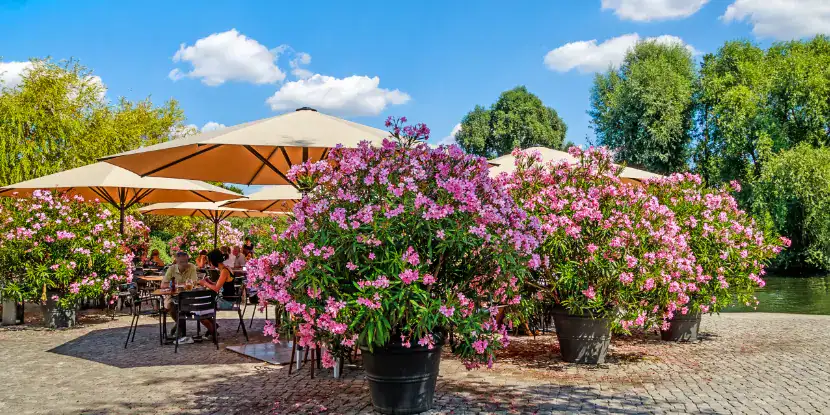
Potted oleander plants brighten a brick patio.
Growing Oleander in Pots
Container requirements:
- Minimum 20-gallon capacity for mature plants
- Drainage holes are essential
- Heavy containers provide stability in the wind
Potting mix:
- Well-draining cactus/succulent mix, or
- Create your own: 50% potting soil, 25% perlite, 25% coarse sand
Care adjustments:
- Water more frequently than ground-planted specimens
- Fertilize lightly 2–3 times during the growing season
- Repot every 2–3 years or when root-bound
- Move containers to protected areas during extreme weather
Size management: Choose dwarf cultivars like Petite Pink or Little Red for long-term container success.
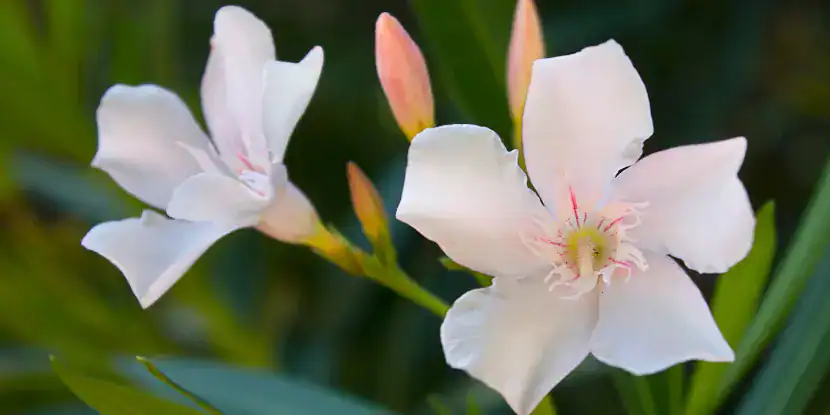
Pure white oleander blossoms.
FAQs: Growing & Caring for Oleander
Q: Is oleander really that toxic?
Yes. All parts contain cardiac glycosides that are dangerous to humans and animals. Even burning oleander produces toxic smoke. Always wear gloves when handling and keep away from children and pets.
Q: How big does oleander get?
Standard varieties are 8–12 feet tall and wide, while dwarf cultivars are 3–6 feet. Size depends on variety, growing conditions, and pruning.
Q: When does oleander bloom?
In Southern California, oleander typically blooms from late spring through fall. In mild winters, some varieties flower nearly year-round.
Q: Can I grow oleander from seeds?
Seeds are viable but slow to germinate and grow. Named cultivars won’t come true to type from seed. Stem cuttings are much more reliable.
Q: Why isn’t my oleander blooming?
Common causes include insufficient sunlight, over-fertilization (especially nitrogen), recent heavy pruning, or too much water. Oleander blooms best when slightly stressed.
Q: How drought-tolerant is oleander once established?
Extremely drought-tolerant. Established plants can survive on rainfall alone in many Southern California areas, though occasional deep watering during extreme heat improves appearance.
Q: What’s the best oleander variety for small spaces?
Dwarf varieties like ‘Petite Pink,’ ‘Little Red,’ or ‘Petite Salmon’ work well for containers and small gardens, staying under 6 feet.
Q: Can oleander handle coastal conditions?
Oleander tolerates salt spray and coastal winds exceptionally well, making it popular for beachside landscaping throughout Southern California.

